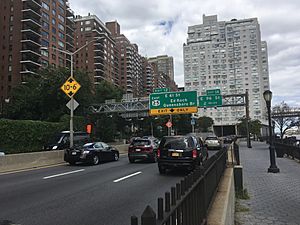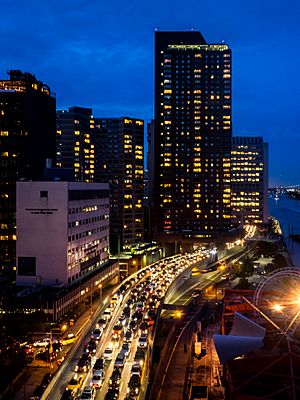FDR Drive facts for kids
Quick facts for kids
Franklin D. Roosevelt East River Drive |
|
|---|---|
| FDR Drive | |
|
FDR Drive highlighted in red
|
|
| Route information | |
| Maintained by NYSDOT and NYCDOT | |
| Length | 9.68 mi (15.58 km) |
| Existed | 1955–present |
| History | Upgraded in 1966 |
| Restrictions | No commercial vehicles between Exits 1-7 & Exits 9-18 No buses north of exit 7 |
| Major junctions | |
| South end | |
|
|
| North end | |
| Location | |
| Counties: | New York |
| Highway system | |
| Numbered highways in New York Interstate • U.S. • N.Y. (former) • Reference • County |
|
The Franklin D. Roosevelt East River Drive, usually called the FDR Drive, is a major road in New York City. It's a special type of highway called a parkway, which means it's often designed to be scenic. This road stretches for about 9.68 miles (15.58 km) along the eastern side of Manhattan.
The FDR Drive starts near the southern tip of Manhattan. It then travels north along the East River. The road ends where it connects to the Harlem River Drive in East Harlem. Along its path, the FDR Drive changes a lot. Some parts are underground, some are at ground level, and some are high up on bridges. It also goes through three tunnels.
Because it's a parkway, large trucks and commercial vehicles are usually not allowed on most of the FDR Drive. Also, buses can't use the northern parts of the road. This is because the road has limits on how heavy vehicles can be and how tall they can be.
Contents
Exploring the FDR Drive: A Route Overview
The FDR Drive follows the East River closely. For most of its length, you can find the East River Greenway right next to it. This greenway is a path for walking and biking.
Downtown Manhattan: Starting the Journey
The FDR Drive begins in Manhattan's Financial District. It comes out of an underground tunnel called the Battery Park Underpass. From there, it becomes an elevated road, meaning it's raised above South Street.
As you drive north, you'll see famous bridges. The road passes under the Brooklyn Bridge and the Manhattan Bridge. After these bridges, the road goes back to ground level. It continues through neighborhoods like the Lower East Side.
Near Houston Street, the FDR Drive dips under the street in a short tunnel. Further north, it passes a large power station. A former exit near 15th Street was closed after 2001 for security reasons.
Around 18th Street, the road goes back up onto an elevated section. This part serves the Kips Bay area.
Midtown Manhattan: Through the City's Heart
In Midtown, the FDR Drive is mostly at ground level. You'll see the Waterside Plaza complex along the river. The road then goes back up onto an elevated section around 28th Street.
A special feature is the northbound exit for 42nd Street. This exit leads to Turtle Bay.
One of the most interesting parts is near the United Nations Headquarters. The road actually goes under the United Nations buildings in a section often called the United Nations Tunnel. It's like driving right through a famous landmark!
After the UN area, the road enters another tunnel called the Sutton Place Tunnel. This tunnel goes under apartment buildings. Inside this tunnel, the southbound lanes are actually above the northbound lanes. This design helps connect to the Queensboro Bridge.
Uptown Manhattan: Heading North
As the FDR Drive continues north, it passes under more buildings. It goes under parts of Rockefeller University and NewYork–Presbyterian Hospital.
Further north, between 81st and 90th streets, there's another double-decker section. The southbound road is again above the northbound road. This part goes under Carl Schurz Park. This park has a nice promenade built over the highway. You can also see Gracie Mansion, which is the official home of the New York City mayor.
The road then goes back to ground level. It passes through East Harlem. Finally, the FDR Drive connects to the Robert F. Kennedy Bridge (also known as the Triborough Bridge) and the Willis Avenue Bridge. After these connections, the FDR Drive becomes the Harlem River Drive, continuing its journey north.
Building the FDR Drive: A Look at Its History
The idea for a road along the East River in Manhattan came about in 1929. The goal was to build a parkway that would stretch for about 3.5 miles (5.6 km).
The first parts of the East River Drive were built in the 1930s. Robert Moses, a famous city planner, was in charge of the design. It was tricky to build a road right next to the river without disturbing people living nearby.
Some sections of the road were finished in the mid-1930s. For example, the part from 125th Street down to 92nd Street was done by 1936. Many early sections were built at ground level.
Over time, city officials decided to make the road better. They wanted to separate the highway from local streets. This meant building elevated sections and tunnels. For example, a section from 51st to 60th Streets was built with two levels.
A very interesting fact about the FDR Drive is how some parts were built. The section between 23rd and 34th Streets was finished in 1941. It was built using rubble, or broken pieces of buildings, from Bristol, England. During World War II, German planes bombed Bristol heavily. Ships would deliver supplies to England and then load up with this rubble as ballast (weight to keep the ship stable) for their trip back to New York. This rubble was then used to help build the FDR Drive!
In June 1945, after the death of President Franklin D. Roosevelt, the East River Drive was named in his honor. That's why it's now commonly called the "FDR Drive."
More elevated sections were added in the 1940s and 1950s. These upgrades helped turn the original boulevard into the full parkway we see today.
Transportation on the FDR Drive
The FDR Drive is used by many express buses in New York City. These buses help people travel quickly between different parts of Manhattan and other boroughs.
For example, some express buses use the FDR Drive to go from Lower Manhattan to 23rd Street. Other buses use it between the Brooklyn Bridge exit and 34th Street. During busy times, some "Midtown Express" buses use the FDR Drive to skip downtown areas and go straight to Midtown.
Images for kids
- FDR Drive at Alps' Roads
See also
 In Spanish: Franklin D. Roosevelt East River Drive para niños
In Spanish: Franklin D. Roosevelt East River Drive para niños







